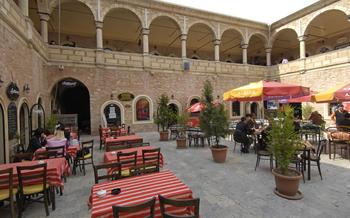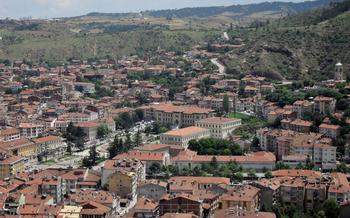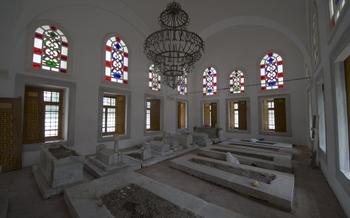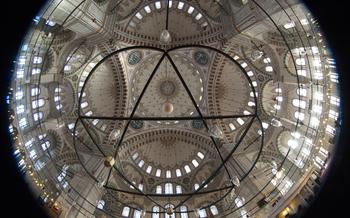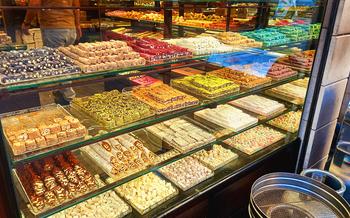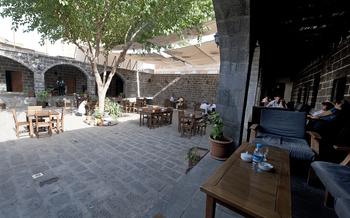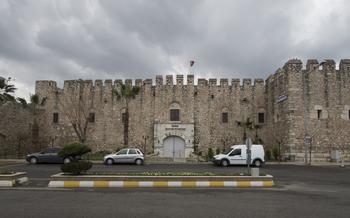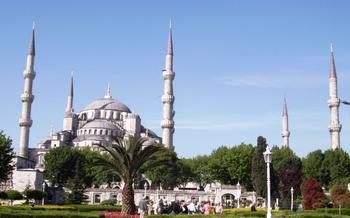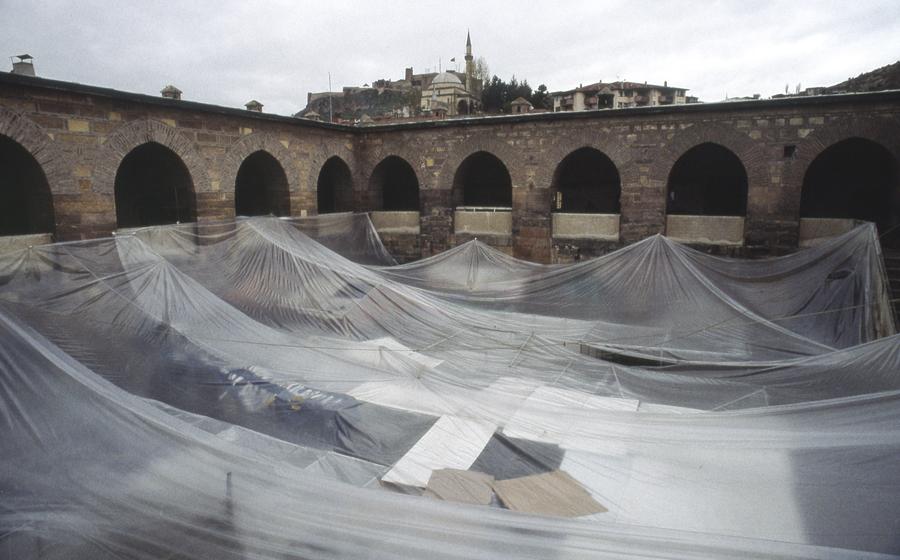
Kursunlu Han
- Historical Significance
- Architectural Features
- Courtyard and Caravanserai
- Religious Significance
- Economic and Trade Importance
- UNESCO World Heritage Site
- Restoration and Renovation
- Present-Day Use
- Local Customs and Traditions
- Visitor Information
- Photography Tips
- Historical Figures and Legends: A Tapestry of Tales and Personalities
- Local Cuisine and Delicacies
- Insider Tip
Historical Significance
The Kursunlu Han, a magnificent caravanserai nestled in the heart of Kastamonu, Turkey, holds immense historical significance. Built in the 17th century during the reign of the Ottoman Empire, the han served as a vital resting point for travelers and traders traversing the ancient Silk Road. Its strategic location along this crucial trade route made it a bustling hub of commerce and cultural exchange. The architectural grandeur of the han reflects the architectural prowess of the Ottomans, showcasing their mastery of design and construction. As a testament to its enduring legacy, the Kursunlu Han has been recognized as a UNESCO World Heritage Site, solidifying its place in the annals of history.
Architectural Features
The Kursunlu Han stands as a testament to the architectural prowess of the Seljuk era. Constructed using locally sourced stone, the han exhibits a harmonious blend of functionality and aesthetics. The building's exterior boasts intricate carvings, geometric patterns, and decorative elements that showcase the artistry and craftsmanship of Seljuk builders. The main entrance, adorned with an impressive arched gateway, invites visitors into a world of architectural wonders. Inside, the han features a spacious courtyard surrounded by two-story structures that once served as living quarters for travelers. These structures are characterized by their arched windows, vaulted ceilings, and decorative niches that create a visually appealing and welcoming atmosphere. The courtyard itself is paved with cobblestones, adding to the han's rustic charm and historical allure.
Courtyard and Caravanserai
The courtyard of the Kursunlu Han is a central feature of the building, serving as a communal space for travelers to gather, rest, and socialize. It is surrounded by a two-story arcade supported by elegant stone columns, creating a sheltered and inviting environment. The courtyard is paved with large stone slabs, and in its center stands a beautiful fountain, providing a refreshing respite from the heat and dust of the road.
The courtyard also functioned as a caravanserai, offering travelers a safe and comfortable place to stay overnight. Along the arcades, there are numerous rooms that were once used as living quarters for merchants and their goods. These rooms are typically small and simple, but they provided basic amenities such as beds, rugs, and storage space. The han also had stables for horses and other animals, ensuring that travelers could safely rest their mounts while they stayed at the han.
Religious Significance
The Kursunlu Han also holds religious significance as a place of worship and spiritual retreat for travelers. Within the han, there is a small mosque that served as a place of prayer for Muslim merchants and visitors. The mosque features a mihrab, indicating the direction of Mecca, and is adorned with intricate tilework and calligraphy. The presence of a mosque within the han reflects the importance of religion in the lives of those who traveled along the trade routes.
Moreover, the han provided a safe and welcoming environment for travelers of different faiths. Non-Muslim merchants and travelers were free to practice their own religious customs and traditions within the han, fostering a spirit of tolerance and understanding. The Kursunlu Han thus served as a place where people from diverse backgrounds could come together, share their beliefs, and find common ground in their shared humanity.
Economic and Trade Importance
The Kursunlu Han served as a vital economic hub and trading center throughout history. Its strategic location along trade routes made it a prime destination for merchants and traders from various regions. Caravans carrying goods from the East, such as spices, silk, and precious stones, would stop at the han before continuing their journey to the West. Conversely, goods from the West, such as textiles, metalware, and glassware, were brought to the han to be traded with Eastern merchants.
The han's large courtyard and storage facilities allowed merchants to store their goods safely while conducting business. The presence of stables and animal pens provided for the care and well-being of pack animals, ensuring their readiness for the next leg of their journey. The han's proximity to nearby markets and bazaars further facilitated trading activities, creating a vibrant marketplace where goods were exchanged and economic transactions took place.
The Kursunlu Han's role in trade not only contributed to the local economy but also played a significant role in the development of regional and international trade networks. It served as a gateway for goods and ideas to flow between different cultures, fostering cultural exchange and economic growth throughout the region.
UNESCO World Heritage Site
The Kursunlu Han's exceptional historical and architectural value has been recognized by UNESCO, which designated it as a World Heritage Site in 20This prestigious designation was granted based on several criteria, including the han's outstanding representation of a cultural tradition, its unique testimony to a civilization, and its exceptional architectural and technological achievements. The Kursunlu Han is regarded as an exceptional example of a well-preserved caravanserai, demonstrating the fusion of architectural styles and the significance of trade and travel routes in the region. Its inclusion on the UNESCO World Heritage List underscores its importance as a cultural and historical treasure, ensuring its preservation and protection for future generations. This designation has also contributed to raising awareness of the han's significance, attracting visitors from around the world who are eager to explore this architectural masterpiece and delve into its rich history.
Restoration and Renovation
The Kursunlu Han has undergone extensive restoration and renovation efforts over the years to preserve its historical integrity while adapting it to modern needs. The process was challenging, requiring meticulous attention to detail and collaboration with experts in conservation and architecture.
Restorers faced the challenge of maintaining the original architectural features while addressing structural issues and incorporating modern amenities. They carefully repaired damaged stonework, restored intricate carvings, and reinforced weakened foundations. The courtyard and living quarters were renovated to provide comfortable accommodation for visitors, while retaining their historical charm.
The restoration project also involved the installation of modern amenities such as lighting, heating, and plumbing, ensuring the comfort and safety of visitors without compromising the han's authenticity. The aim was to strike a balance between preserving the past and adapting to the present, creating a space that is both historically significant and accessible to modern-day travelers.
The successful restoration of the Kursunlu Han showcases the commitment to preserving Turkey's cultural heritage while ensuring its relevance in the modern era. The han stands as a testament to the enduring legacy of the Silk Road and continues to captivate visitors with its architectural beauty and historical significance.
Present-Day Use
The Kursunlu Han has undergone a remarkable transformation in recent years, evolving from a historical caravanserai into a vibrant cultural and historical attraction. Today, the han stands as a testament to the region's rich heritage while embracing modern-day needs and interests.
Carefully restored and renovated, the han now houses a museum that showcases artifacts, historical documents, and exhibits related to the history of the building and the region. Visitors can wander through the museum's galleries, gaining insights into the lives of the travelers and merchants who once frequented this bustling caravanserai.
In addition to the museum, the Kursunlu Han also hosts a variety of cultural events, exhibitions, and activities throughout the year. These events celebrate the region's traditional arts, crafts, music, and dance, providing visitors with an immersive experience of Turkish culture.
The han's courtyard, once a bustling hub of activity, now serves as a charming outdoor venue for concerts, performances, and traditional Turkish celebrations. Visitors can relax in the shade of the trees, savor the flavors of local cuisine, and enjoy the vibrant atmosphere of these cultural events.
Whether exploring the museum's exhibits, attending a cultural event, or simply soaking in the historical ambiance, a visit to the Kursunlu Han offers a unique blend of history, culture, and modern-day attractions, ensuring a memorable experience for visitors of all ages.
Local Customs and Traditions
The Kursunlu Han is deeply embedded in the local customs and traditions of the region. One unique practice observed at the han is the "Kervan Sofrası" or Caravan Table. This tradition dates back to the days when the han served as a resting place for traveling merchants and caravans. During the evening, travelers would gather around a communal table and share a meal together. This tradition fostered a sense of community and camaraderie among the travelers, who would often exchange stories and experiences from their journeys.
Another significant tradition associated with the Kursunlu Han is the "Hacı Baba Duası" or Haji Baba's Prayer. According to legend, a pious man named Haji Baba once stayed at the han and prayed for its prosperity and safety. It is believed that Haji Baba's prayer was answered, and the han has since been blessed with good fortune. Visitors to the han often light candles and offer prayers at the spot where Haji Baba is said to have prayed, seeking blessings and protection for their travels.
Visitor Information
Planning a visit to the Kursunlu Han is a rewarding experience for travelers seeking historical and cultural immersion. The han is open to visitors daily from 9 am to 5 pm, allowing ample time to explore its architectural marvels and delve into its rich history. Admission fees are reasonably priced, and guided tours can be arranged for a more in-depth understanding of the han's significance.
Facilities within the Kursunlu Han cater to the needs of modern travelers. Restrooms are available for convenience, ensuring a comfortable visit. Parking is also provided, making it easy for visitors arriving by car. Accessibility options, such as ramps and elevators, have been implemented to accommodate visitors with disabilities.
To fully appreciate the tranquil ambiance of the Kursunlu Han, it is advisable to avoid peak tourist seasons and visit during the shoulder months (April-May and September-October). During this time, visitors can wander through the courtyard and caravanserais without the hustle and bustle of large crowds, allowing for a more serene and immersive experience.
Photography Tips
To capture the beauty and grandeur of the Kursunlu Han through photography, consider these tips:
-
Golden Hour Magic: Plan your visit during the golden hours of sunrise or sunset to take advantage of the warm, diffused light that casts a magical glow on the han's architecture.
-
Wide-angle Wonders: Utilize a wide-angle lens to capture the expansive courtyard and the intricate details of the han's facade in a single frame.
-
Symmetrical Symmetry: Position yourself in the center of the courtyard to create symmetrical shots that showcase the harmony and balance of the han's design.
-
Interior Explorations: Venture inside the han to capture the atmospheric ambiance of the caravanserai, focusing on the arched doorways, vaulted ceilings, and worn stone surfaces.
-
Human Element: Add a human element to your photographs by including travelers or locals interacting with the han, creating a sense of scale and conveying the historical significance of the place.
Historical Figures and Legends: A Tapestry of Tales and Personalities
The Kursunlu Han is not only a testament to architectural ingenuity but also a stage upon which the drama of history unfolded. Legends and stories intertwine with the han's stones, whispering tales of renowned figures who once graced its threshold. One such figure is Evliya Çelebi, the renowned Ottoman traveler and writer. In his extensive travelogue, Çelebi vividly describes his stay at the Kursunlu Han, marveling at its grandeur and the bustling activity within its walls. His words transport us back in time, allowing us to glimpse the vibrant world of the han during the 17th century.
Another notable visitor was the German diplomat and scholar, Philipp von Bruckmann. In his book, "Reisebriefe aus der Türkei," Bruckmann shares his experiences at the Kursunlu Han, where he was captivated by its architectural beauty and the warmth of the local people. His detailed descriptions provide a valuable record of the han's condition and significance in the 19th century.
These historical figures are but a few of the many who have left their mark on the Kursunlu Han. Each story, each legend, adds a layer of depth and intrigue to the already rich tapestry of the han's history. As you wander through its courtyards and chambers, let your imagination soar, and allow the whispers of the past to guide you on a journey through time.
Local Cuisine and Delicacies
A visit to the Kursunlu Han is not complete without savoring the delectable local cuisine. The region of Kastamonu boasts a rich culinary heritage, influenced by diverse cultures and traditions. Visitors can indulge in mouthwatering dishes that showcase the freshest ingredients and unique flavors.
Must-Try Dishes:
Kastamonu Tirit: A hearty and flavorful dish made with shredded bread, lamb stew, and yogurt. The tender lamb is slow-cooked with aromatic spices, creating a rich and savory broth. Served with crusty bread, this dish is a local favorite.
Kabak Tatlisi: A delightful dessert made with sweet pumpkin, shredded coconut, and walnuts. The pumpkin is simmered in a delicate syrup until it becomes tender and infused with a subtle sweetness. Topped with coconut and walnuts, this dessert offers a perfect balance of flavors and textures.
Etli Ekmek: A traditional Turkish flatbread filled with seasoned ground beef. The dough is rolled thin and topped with a generous amount of meat, onions, and spices. Baked in a stone oven, the etli ekmek has a crispy crust and a juicy, flavorful filling.
Çökelek Çorbası: A creamy and tangy soup made with strained yogurt, wheat flour, and spices. The yogurt is mixed with flour and cooked until it thickens, creating a smooth and velvety texture. Seasoned with garlic, mint, and red pepper flakes, this soup offers a unique and refreshing taste.
Golaga: A sweet and chewy pastry filled with walnuts and honey. The dough is rolled thin and filled with a mixture of chopped walnuts, honey, and spices. Baked until golden brown, the golaga has a crispy exterior and a soft, gooey interior.
Visitors can find these delicacies at local restaurants and eateries in the vicinity of the Kursunlu Han. Indulging in the local cuisine is an excellent way to immerse oneself in the region's culinary traditions and create lasting memories.
Insider Tip
As you explore the Kursunlu Han, take a moment to step into the han's old stables, which have been lovingly restored and now house a small museum. Here, you'll find a collection of artifacts, tools, and documents that offer a glimpse into the daily life and workings of the han during its heyday as a bustling trade center. From ancient coins and pottery fragments to old ledgers and trade records, these relics tell the stories of the merchants, travelers, and animals that once passed through these historic gates. Don't miss this hidden gem for a deeper understanding of the han's rich history and the vibrant tapestry of life that unfolded within its walls.
